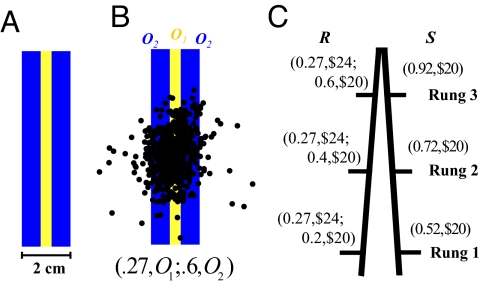Fig. 1.
Construction of a motor lottery and task design. (A) A stimulus configuration containing 2 non-zero monetary outcomes, O1 and O2, where O1 > O2 > O. The subject earned O1 by hitting the yellow bar, O2 by hitting either of the blue bars, and O if his/her movement endpoint fell elsewhere on the touch screen. The subject had to complete the pointing movement in <700 ms to avoid a large penalty. (B) From one subject with motor uncertainty σ = 6.57 mm, 623 movement endpoints were superimposed on the configuration. For this subject, this configuration was equivalent to a lottery (0.27,O1; 0.6,O2; 0.13,O). (C) Common consequence task. The bottom rung was the pair R (0.27,$24; 0.2,$20,0.53,0) and S (0.52,$20; 0.48,0). Each higher rung was constructed by adding a “common consequence” (0.2,$20) to both lotteries in the rung below it. The lottery in each pair with the higher probability of winning the highest amount ($24 in this example) and the zero outcome was designated as “riskier” (R), whereas the other lottery was designated as safer (S). If the subject's frequency of choosing the R lotteries is the same across rungs, his performance is consistent with the independence axiom.

